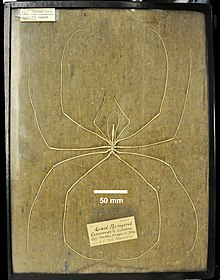Colossendeis colossea
| Colossendeis colossea | |
|---|---|

| |
| Scientific classification | |
| Domain: | Eukaryota |
| Kingdom: | Animalia |
| Phylum: | Arthropoda |
| Subphylum: | Chelicerata |
| Class: | Pycnogonida |
| Order: | Pantopoda |
| Family: | Colossendeidae |
| Genus: | Colossendeis |
| Species: | C. colossea |
| Binomial name | |
| Colossendeis colossea | |
Colossendeis colossea is a species of sea spider (class Pycnogonida) in the family Colossendeidae.[2] The species was first described by Edmund B. Wilson in 1881.[1][2] It is the largest pycnogonid species known to science, reaching a leg span of 70 cm (28 in). Body length, including proboscis and abdomen, can reach 7 cm (2.8 in).[3]
Colossendeis colossea is a deep-water species inhabiting continental slopes at depths between 420 and 5,200 m (1,380 and 17,060 ft) m.[3] It has a semi-cosmopolitan distribution[2] in all main oceans apart from the Arctic Ocean.[3]
References
- ^ a b Wilson, Edmund B. (1881). "Report on the Pycnogonidae. Reports on the Results of Dredging, under the supervision of Alexander Agassiz, along the east coast of the United States during the summer of 1880, by the U. S. Coast Survey Steamer "Blake", Commander JR Bartlett, U. S. N., Commanding". Bulletin of the Museum of Comparative Zoology at Harvard College. 8 (2): 239–256.
- ^ a b c Bamber RN, El Nagar A, Arango C (eds.). "Colossendeis colossea". Pycnobase: World Pycnogonida Database. World Register of Marine Species. Retrieved 4 March 2024.
- ^ a b c Vinu, Jacob; Rajeesh Kumar, M. P.; Sumod, K. S.; Deepa, K. P.; Hashim, M.; Sanjeevan, V. N.; Sudhakar, M. (2016). "First record of deep-sea gigantic pycnogonid Colossendeis colossea Wilson, 1881 from the Western Indian Ocean". Marine Biodiversity. 46 (2): 495–498. doi:10.1007/s12526-015-0373-1.
